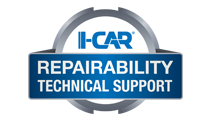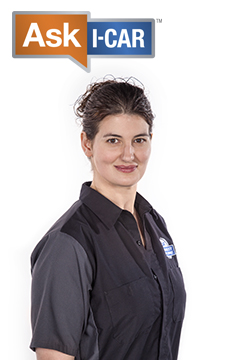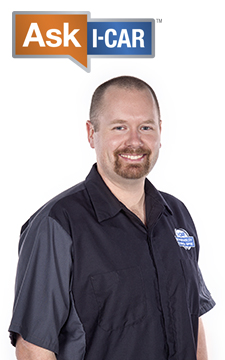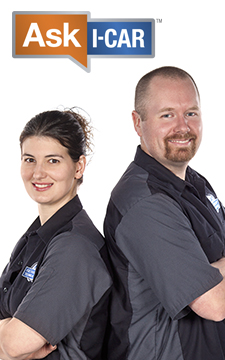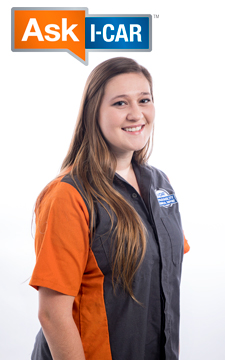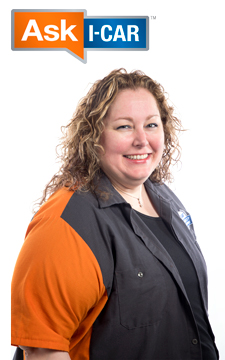I-CAR OEM Technical Information Matrix: What Is It, And How Does It Help? UPDATE
Posted on 5 December 2024Do you know which vehicle makers have collision repair information available? Do you know where you can go to find that out?
Porsche Position Statement: Prohibition of Porsche Rim Repairs
Posted on 18 September 2024Porsche has released a position statement pertaining to wheel repairs.
Bumper Cover Repair With ADAS: Porsche - UPDATE
Posted on 10 September 2024A simple bumper repair on a modern vehicle may not be as simple as it seems. New technologies like blind spot monitoring, adaptive cruise control, and other advanced driver assistance systems (ADAS) utilize sensors behind the bumper covers. The ability for these sensors to be able to see clearly, normally requires special caution when considering a bumper repair. Many OEMs have different levels of warnings when it comes to repairing bumper covers with ADAS. So, what does Porsche say on the subject?
Porsche Collision Position Statements Available
Posted on 5 September 2024Porsche position statements can now be accessed directly from the I-CAR Repairability Technical Support (RTS) Portal.
Locating OEM-Approved HV Tools: Porsche
Posted on 21 April 2023When researching procedures for disabling a high-voltage (HV) vehicle, you may notice that many of the procedures require the use of specific tools. Some of them are OEM-specific tools or scan tools. Often identifying and locating where to purchase these specific tools can be difficult.
OEM Emergency Response Guides: Porsche
Posted on 1 March 2023Are you looking for OEM emergency response guides (ERGs)? The Repairability Technical Support (RTS) team has located these guides and either houses them on the RTS website, provides links to webpages that house them, or provides articles with instructions on how to locate them.
These guides provide information about the vehicle that is useful to emergency response personnel. You may find ERGs available for many types of vehicles, but most OEMs focus on how to handle a high-voltage (HV) vehicle that has been involved in a collision.
OEM Emergency Response Guides
Posted on 25 February 2021Are you looking for OEM emergency response guides (ERGs)? The Repairability Technical Support (RTS) team has located these guides and either houses them on the RTS website, provides links to webpages that house them, or provides articles with instructions on how to locate them.
Vehicle Technology And Trends 2020
Posted on 29 October 2019The 2020 model year vehicles are starting to roll off the assembly line and into showrooms. The I-CAR course, Vehicle Technology And Trends 2020, covers the technology, model releases, and trends. Keeping up-to-date on the 2020 models and features is vital to the blueprinting and repair process.
ADAS, Calibration, And Scanning Article Hotspot
Posted on 14 January 2019Since advanced driver assistance systems (ADAS), scanning, and calibration first started becoming relevant, members of the collision repair industry have required as much knowledge as possible on these subjects. I-CAR’s Repairability Technical Support (RTS) team continues to be on the leading edge of research and education. Our goal is to help communicate information to the industry, and a great way to do this is through Collision Repair News articles.
Repairer Driven News: Porsche Explains Ban On Wheel Repairs
Posted on 17 December 2018Repairer Driven News (RDN) published an article on why technicians at Porsche have told the repair industry that technicians are to never repair Porsche wheels. A collision repair technology instructor for Porsche named Mike Kukavica elaborated on why this rule was put in place.
Structural Sectioning Procedures: Porsche
Posted on 5 July 2017Ask I-CAR receives many technical inquiries referring to sectioning. The collision repair industry wants to know where can you section, does the OEM have a sectioning procedure, and where can I find the sectioning procedure? Most OEMs allow sectioning to outer body panels and the front and rear rails. Sectioning reinforcements is not as common, as most reinforcements are replaced at factory seams.
Weld-Through Primer Guidelines: Porsche
Posted on 24 April 2017Weld-through primers are generally a zinc-based product that are applied to the mating surfaces prior to welding. Corroding zinc forms zinc oxide which protects the steel. This is called sacrificial corrosion. For a quality weld to be made it’s required that the weld-through primer be removed from the direct weld zone before welding the joint when GMA welding. Many OEMs have a position on when and how to use weld-through primer or when it shouldn’t be utilized. Let’s see what Porsche recommends and where this information can be found.
Always Follow Vehicle Maker Procedures
Posted on 7 July 2016We often receive Ask I-CAR inquiries asking: “what does I-CAR recommend?” Many times these questions are in regards to sectioning, straightening, or part replacement/attachment methods. Our first response is always:
What's A Porsche Rear End Well?
Posted on 19 February 2016When it comes to repair information, vehicle makers use a wide variety of terminology for replacement parts. All of the different names can be confusing, especially when repairing a variety of vehicle makes and models.
Today’s Advanced Vehicles Require Changes in Collision Repair Attachment Methods - Part 1
Posted on 20 December 2014This article originally appeared in the November/December edition of Fixed Ops Magazine.
Collision repair professionals are no different than any other professional – we are resistant to change. It took many years for repairers to make the switch to “MIG welding” for welding early unibody vehicles. (For this article we’ll use the term gas metal arc welding (GMAW) metal inert gas (MIG), or GMA (MIG)). (More on the reason, later.) It was a technology that was unfamiliar to many and there wasn’t a perceived need for change. History would prove otherwise, as there may not be a collision repair business in the country that doesn’t have a GMA (MIG) welder.
Repair or Replace? – Material Tensile Strength Key to Repairability
Posted on 23 September 2014Repair or Replace? – Material Tensile Strength Key to Repairability
Jason Bartanen, I-CAR Director, Industry Technical Relations
The world of steels continues to evolve at a rapid pace and repair professionals need to keep up. In order to perform complete, safe, and quality repairs, it’s imperative to identify the type of material we’re working with, to know what is repairable, and know which options we have for part replacement when straightening is not an option.
Weld-Through Primer Requirements On The OEM Technical Information Matrix
Posted on 28 August 2014Let's continue our breakdown of the columns in the OEM Technical Information Matrix. The eighth column calls out if the vehicle maker requires the use of weld-through primer on flanges in preparation for welding.
Collision Repair Attachment Methods, Description, And Equipment Requirements Information On The OEM Technical Information Matrix
Posted on 13 August 2014Let's continue our breakdown of the columns in the OEM Technical Information Matrix. The seventh column calls out if the vehicle maker has information in regard to the recommended attachment method and the equipment required for complete, quality, and safe repairs.
It's Not Just About Aluminum
Posted on 30 July 2014Today's Vehicles Require Updated Collision Repair Tools And Training
by Jason Bartanen
Ever since the unveiling of the 2015 Ford F-150 at the North American International Auto Show in Detroit in January, the U.S. automotive industry has been buzzing about this game changing, aluminum intensive vehicle.
Is There a Procedure for Disassembling a Service Assembly?
Posted on 19 June 2014The fourth column in the OEM Technical Information Matrix: Partial Service Part/Assembly Replacement Procedures at Factory Seams, can get a little tricky without further clarification. For the most part, this is a column that I-CAR is still researching published OEM information to get the answers to. The question is: Does the vehicle maker have procedures for replacing a partial service part or assembly at factory seams?
The Aluminum Difference
Posted on 9 December 2013What's Iowa Got To Do With It?
by Jason Bartanen
We've seen a lot of changes in vehicle technology over the years. With each of these changes come new challenges and new opportunities. When the unibody vehicle was introduced, repair professionals were required to change their approach to collision repair, from damage analysis through the repair process. With the introduction of GMA (MIG) welding, additional requirements for repairs included new training and equipment. And passive restraints systems presented a completely different type of challenge, involving electronics and diagnostics.
Front Lower Rail Section With No Welding
Posted on 27 February 2013If there is a sectioning procedure on a front lower rail, GMA welding across a seam is the usual method for attaching the new joint. On at least two late model Porsche vehicles, however, there is a front lower rail sectioning procedure that uses no welds at all. The rails on the Panamera, since 2010, and the 911, since 2012, both have aluminum construction.
